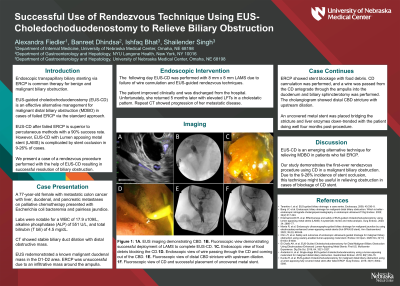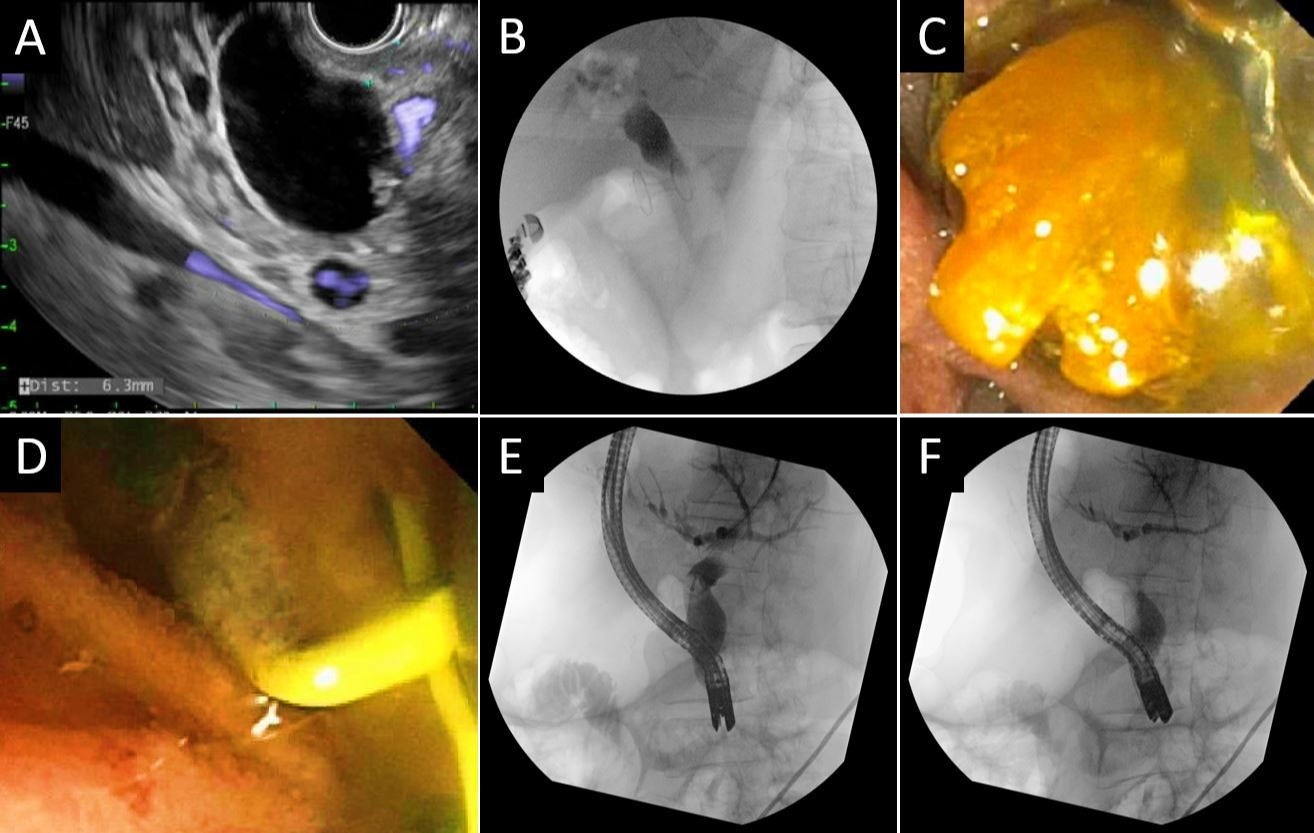Tuesday Poster Session
Category: Interventional Endoscopy
P3759 - Successful Use of Rendezvous Technique Using EUS-Choledochoduodenostomy to Relieve Biliary Obstruction
Tuesday, October 24, 2023
10:30 AM - 4:00 PM PT
Location: Exhibit Hall

Has Audio
.jpg)
Alexandra R. Fiedler, MD
University of Nebraska Medical Center
Omaha, NE
Presenting Author(s)
Alexandra R. Fiedler, MD, Banreet S. Dhindsa, MD, Ishfaq Bhat, MD, Shailender Singh, MD
University of Nebraska Medical Center, Omaha, NE
Introduction: Endoscopic transpapillary biliary stenting via endoscopic retrograde cholangiopancreatography (ERCP) is the most common therapy for benign and malignant biliary obstruction. Endoscopic ultrasound-guided choledochoduodenostomy (EUS-CD) is an effective alternative management for malignant distal biliary obstruction (MDBO) in cases of failed ERCP via the standard approach. EUS-CD after failed ERCP is superior to percutaneous methods with a 90% success rate. However, EUS-CD with Lumen apposing metal stent (LAMS) is complicated by stent occlusion in 9-26% of cases. We present a case of a rendezvous procedure performed with the help of EUS-CD resulting in successful resolution of biliary obstruction.
Case Description/Methods: A 77-year-old female with metastatic colon cancer with liver, duodenal, and pancreatic metastases on palliative chemotherapy presented with Escherichia coli bacteremia and painless jaundice with white blood cell count of 17.9 x109/L, alkaline phosphatase (ALP) of 551 U/L, and total bilirubin (T bili) of 4.5 mg/dL. Computed Tomography (CT) showed stable biliary duct dilation with distal obstructive mass. EUS redemonstrated a known malignant duodenal mass in the D1-D2 area. ERCP was unsuccessful due to an infiltrative mass around the ampulla. The procedure was repeated the following day and EUS-CD was performed with 8 mm x 8 mm LAMS due to failure of wire cannulation and EUS-guided rendezvous techniques. The patient improved clinically, her liver function tests (LFTs) improved, and she was discharged from the hospital. Five months later she represented with elevated LFTs in a cholestatic pattern. Repeat CT showed further progression of the disease. ERCP showed stent blockage with food debris. CD cannulation was performed, and a wire was passed from the CD antegrade through the ampulla into the duodenum and biliary sphincterotomy was performed. The cholangiogram showed distal CBD stricture with upstream dilation. An uncovered metal stent was placed bridging the stricture and LFTs downtrended with the patient doing well four months post-procedure.
Discussion: EUS-CD is an emerging alternative technique for relieving MDBO in patients who fail ERCP. Our study demonstrates the first-ever rendezvous procedure using CD in a malignant biliary obstruction. Due to the 9-26% incidence of stent occlusion, this technique might be useful in relieving obstruction in cases of blockage of CD stent.

Disclosures:
Alexandra R. Fiedler, MD, Banreet S. Dhindsa, MD, Ishfaq Bhat, MD, Shailender Singh, MD. P3759 - Successful Use of Rendezvous Technique Using EUS-Choledochoduodenostomy to Relieve Biliary Obstruction, ACG 2023 Annual Scientific Meeting Abstracts. Vancouver, BC, Canada: American College of Gastroenterology.
University of Nebraska Medical Center, Omaha, NE
Introduction: Endoscopic transpapillary biliary stenting via endoscopic retrograde cholangiopancreatography (ERCP) is the most common therapy for benign and malignant biliary obstruction. Endoscopic ultrasound-guided choledochoduodenostomy (EUS-CD) is an effective alternative management for malignant distal biliary obstruction (MDBO) in cases of failed ERCP via the standard approach. EUS-CD after failed ERCP is superior to percutaneous methods with a 90% success rate. However, EUS-CD with Lumen apposing metal stent (LAMS) is complicated by stent occlusion in 9-26% of cases. We present a case of a rendezvous procedure performed with the help of EUS-CD resulting in successful resolution of biliary obstruction.
Case Description/Methods: A 77-year-old female with metastatic colon cancer with liver, duodenal, and pancreatic metastases on palliative chemotherapy presented with Escherichia coli bacteremia and painless jaundice with white blood cell count of 17.9 x109/L, alkaline phosphatase (ALP) of 551 U/L, and total bilirubin (T bili) of 4.5 mg/dL. Computed Tomography (CT) showed stable biliary duct dilation with distal obstructive mass. EUS redemonstrated a known malignant duodenal mass in the D1-D2 area. ERCP was unsuccessful due to an infiltrative mass around the ampulla. The procedure was repeated the following day and EUS-CD was performed with 8 mm x 8 mm LAMS due to failure of wire cannulation and EUS-guided rendezvous techniques. The patient improved clinically, her liver function tests (LFTs) improved, and she was discharged from the hospital. Five months later she represented with elevated LFTs in a cholestatic pattern. Repeat CT showed further progression of the disease. ERCP showed stent blockage with food debris. CD cannulation was performed, and a wire was passed from the CD antegrade through the ampulla into the duodenum and biliary sphincterotomy was performed. The cholangiogram showed distal CBD stricture with upstream dilation. An uncovered metal stent was placed bridging the stricture and LFTs downtrended with the patient doing well four months post-procedure.
Discussion: EUS-CD is an emerging alternative technique for relieving MDBO in patients who fail ERCP. Our study demonstrates the first-ever rendezvous procedure using CD in a malignant biliary obstruction. Due to the 9-26% incidence of stent occlusion, this technique might be useful in relieving obstruction in cases of blockage of CD stent.

Figure: Figure 1: 1A. EUS imaging demonstrating CBD. 1B. Fluoroscopic view demonstrating successful deployment of LAMS to complete EUS-CD. 1C. Endoscopic view of food debris blocking the CD.1D. Endoscopic view of wire passing through the CD and coming out of the CBD. 1E. Fluoroscopic view of distal CBD stricture with upstream dilation. 1F. Fluoroscopic view of CD and successful placement of uncovered metal stent.
Disclosures:
Alexandra Fiedler indicated no relevant financial relationships.
Banreet Dhindsa indicated no relevant financial relationships.
Ishfaq Bhat indicated no relevant financial relationships.
Shailender Singh indicated no relevant financial relationships.
Alexandra R. Fiedler, MD, Banreet S. Dhindsa, MD, Ishfaq Bhat, MD, Shailender Singh, MD. P3759 - Successful Use of Rendezvous Technique Using EUS-Choledochoduodenostomy to Relieve Biliary Obstruction, ACG 2023 Annual Scientific Meeting Abstracts. Vancouver, BC, Canada: American College of Gastroenterology.
